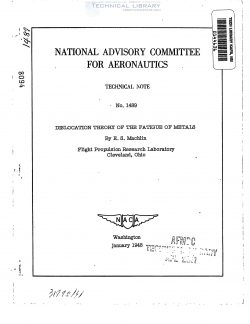naca-tn-1489
- Version
- 157 Downloads
- 1.35 MB File Size
- 1 File Count
- December 4, 2016 Create Date
- December 4, 2016 Last Updated
National Advisory Committee for Aeronautics, Technical Notes - Dislocation Theory of the Fatigue of Metals

A dislocation theory of fatigue failure for annealed solid
solutions is presented. On the basis of this theory, an equation
giving the dependence of the number of cycles for failure on the
stress, the temperature, the material parameters, and the frequency
is derived for uniformly stressed specimens. The equation is found
to be in quantitative agreement with the data. Inasmuch as one
material parameter is indicated to be temperature-dependent and
its temperature dependence is not known, it is impossible to pre-
dict the temperature dependence of the number of cycles for failure.
A predicted quantitative correlation between fatigue and creep is
found to exist, which suggests the practical possibility of obtain-
ing fatigue data for annealed solid solutions and elements from
steady-state creep-rate data for these materials. As a result of
this investigation, a modification of the equation for the steady-
state creep rate previously developed on the basis of dislocation
theory is suggested. Additional data are required to verify
canpletely the dislocation theory of fatigue.
The failure of materials under an oscillating stress, the
maximm value of which is lower than that required to cause failure
in a static tensile test, is termed "fatigue failure." This type
of failure is the limiting factor in the design and the operation
of many rotating parts. In particular, fatigue strength has become
a limiting factor in the development of the gas turbine for air-
craft use. Turbine buckets, for example, have in many cases failed
as a result of fatigue.
Two methods of eliminating the problem of fatigue failure
exist: (1) The design of the parts can be changed to minimize the
effect of oscillating stresses; and (2) the resistance to fatigue
failm‘e of the materials used can be increased. A phase of the
second solution, based on obtaining an understanding of the fatigue
phenomena, is discussed in this report.
Although many experimental investigations of fatigue have been
made, few have been concerned with basic considerations. The work
of Gough and his collaborators (references 1 and 2) , however, is
outstanding in the field. of fundamental fatigue studies. This work
has shown that the phenomena of plastic deformation (slip) and
fatigue are closely related. Some theories have been reported
(references 3 and 4) that relate plastic deformation to fatigue
failure. Because these theories are not of a fundamental nature,
however, they have not yielded basic knowledge of the physical
properties of materials that affect fatigue.
| File | Action |
|---|---|
| naca-tn-1489 Dislocation Theory of the Fatigue of Metals.pdf | Download |

Comment On This Post